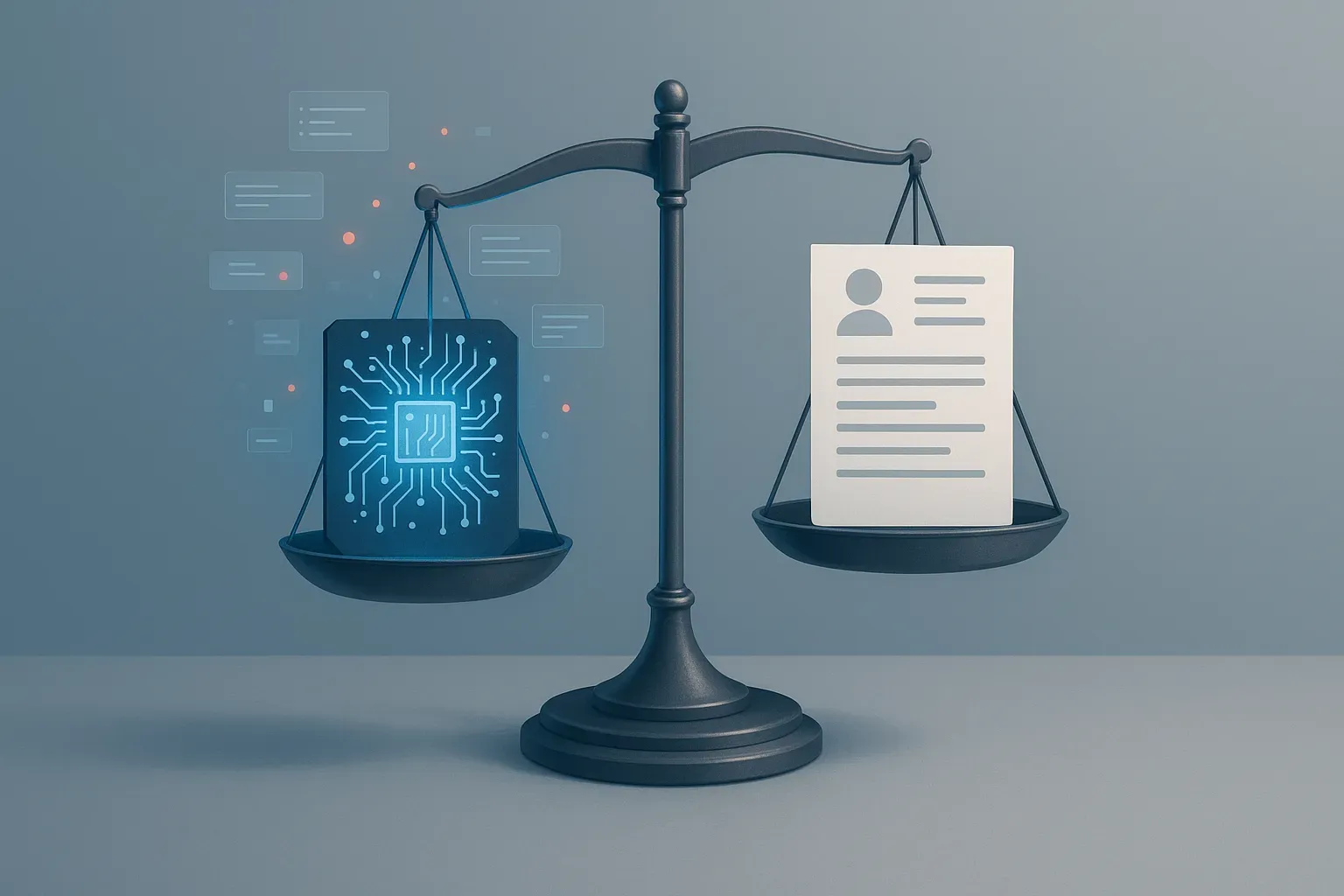Social media algorithms increasingly influence recruitment practices, raising critical questions about fairness and discrimination in hiring processes. Leading experts highlight concerning patterns where these algorithms can perpetuate existing biases, potentially limiting opportunities for qualified candidates from disadvantaged backgrounds. This article explores the delicate balance between technological efficiency and human oversight, offering practical approaches to ensure algorithms serve as supportive tools rather than problematic gatekeepers in recruitment.
- Inherited Prejudices Limit Leadership Diversity
- Use Algorithms as Channels Not Gatekeepers
- Wrong Metrics Amplify Discrimination at Scale
- Social Algorithms Require Human Lens for Fairness
- Optimize for Fairness Not Digital Engagement
- Algorithms Create Blind Spots for Disadvantaged Groups
- Balancing Algorithmic Efficiency with Human Oversight
- Tools Should Support Not Replace Human Judgment
- Manual Sourcing Attracts More Diverse Talent
- Algorithms Need Clear Boundaries in Recruitment
- Technology Supports but Human Connection Prevails
- Three-Pronged Approach Reduces Algorithmic Bias
- Balance Technology with Clear Human Criteria
- Hidden Filters Limit Talent and Future Growth
Inherited Prejudices Limit Leadership Diversity
Social media algorithms in recruitment are a double-edged sword, and we need to talk honestly about both sides. On one hand, they promise efficiency and wider reach. On the other, they can perpetuate exactly the kind of bias we’ve spent decades trying to eliminate from hiring.
Here’s what concerns us most: these algorithms learn from historical data, which means they inherit past prejudices. If your company historically hired certain demographics for leadership roles, the algorithm will prioritize similar profiles going forward. It’s like teaching someone to be discriminatory without meaning to. The technology doesn’t understand context or recognize when it’s making unfair assumptions based on someone’s name, location, educational background, or the types of accounts they follow.
We’ve seen how LinkedIn’s algorithm, for example, can surface candidates based on engagement patterns that have nothing to do with competence. Someone who’s less active on social media isn’t necessarily less qualified; they might just have different priorities or privacy concerns. Yet algorithms often interpret low engagement as low relevance.
The discrimination potential gets even more troubling when you consider intersectionality. Algorithms might filter out candidates based on seemingly neutral criteria that disproportionately affect certain groups. Language patterns, school names, career gaps that could indicate parental leave: all of these can trigger algorithmic bias without anyone explicitly programming discrimination into the system.
What makes this particularly challenging for executive search is that we’re not just filling positions; we’re identifying leaders who will shape organizational culture. When algorithms narrow your candidate pool based on flawed assumptions, you’re not just missing out on talent, you’re potentially excluding the diverse perspectives that drive innovation and better decision-making.
The solution isn’t abandoning technology, it’s demanding better from it. We need algorithms designed with fairness in mind, regular testing for discriminatory outcomes, and the humility to recognize that efficiency should never come at the cost of equity. Your recruitment process should open doors, not quietly close them based on digital patterns that may have nothing to do with someone’s ability to excel in your organization.

Use Algorithms as Channels Not Gatekeepers
Social media algorithms have made recruitment more efficient by helping us reach niche talent pools and passive candidates. However, I believe they come with a double-edged effect. Algorithms are designed to optimize based on patterns, which means they may unintentionally favor certain demographics or replicate existing biases in the data. For example, if a platform’s algorithm is trained on profiles of predominantly male engineers, it may continue to prioritize similar profiles, reducing visibility for equally qualified women in the field.
This is why we use social media as a sourcing channel but never as the final filter. Human judgment and structured evaluation remain central to our hiring process. To mitigate bias, we also ensure our job postings are worded inclusively and that hiring panels are diverse. In my view, algorithms should be treated as tools to broaden reach, not as gatekeepers of talent. Balanced this way, they can add value without compromising fairness.

Wrong Metrics Amplify Discrimination at Scale
Social media algorithms weren’t built for hiring decisions. They were designed to maximize engagement and generate ad revenue.
The problem gets worse when companies apply AI irresponsibly. These algorithms already contain biases from their original purpose, and when you add poor implementation and lack of oversight, you’re amplifying discrimination at scale.
Look, I get why companies screen social media. They want to assess cultural fit and avoid reputation risks, which sometimes seems justified. But here’s the thing: social media context is completely different from professional context.
Your weekend photos don’t predict job performance, your political opinions don’t measure technical skills, and your social network doesn’t indicate leadership ability. Yet algorithms treat these signals as predictive data.
Social screening shouldn’t carry significant weight in hiring decisions because it measures the wrong things. Companies need to focus on what actually matters: demonstrable skills, relevant experience, and actual achievements. That’s the data that predicts success, not your Instagram feed.

Social Algorithms Require Human Lens for Fairness
The rise of social media algorithms has transformed how companies source and evaluate talent. Recruiters can now reach vast candidate pools instantly, targeting profiles that align with specific keywords, skills, or engagement patterns. While efficient, this algorithm-driven approach also raises critical questions about fairness, inclusivity, and bias in the hiring process.
On one hand, algorithms allow recruiters to filter through thousands of applications quickly and highlight potential candidates who might otherwise be overlooked. On the other hand, these same algorithms are only as unbiased as the data they are trained on. If historical hiring data contains bias, or if the algorithm prioritizes certain traits (such as frequent engagement on LinkedIn), it may unintentionally exclude qualified candidates from diverse backgrounds. The danger lies in creating a feedback loop where the system continually favors similar profiles, reinforcing existing inequalities.
Consider a company that relies heavily on algorithmic sourcing from LinkedIn or X (formerly Twitter). If the algorithm favors candidates who have highly polished profiles, frequent engagement, or advanced networks, it may disadvantage introverted professionals, individuals from lower-income backgrounds who lack access to digital branding resources, or those from underrepresented groups who historically face systemic barriers.
Research from Northeastern University highlights this concern: algorithms used in recruitment were shown to amplify gender and racial disparities when trained on biased historical data. Similarly, the Equal Employment Opportunity Commission (EEOC) in the U.S. has raised red flags about algorithmic hiring tools, warning that they may violate anti-discrimination laws if they unintentionally screen out protected groups. Meanwhile, a Harvard Business School study found that many employers miss out on “hidden workers” — qualified candidates overlooked by automated systems due to non-traditional career paths or resume gaps.
Social media algorithms hold undeniable potential to streamline recruitment, but they must be used with caution and transparency. Employers should audit these systems regularly, pair algorithms with human oversight, and commit to inclusive recruitment practices that look beyond digital footprints. Technology can aid efficiency, but fairness in hiring requires a human lens to ensure opportunities are accessible to all.

Optimize for Fairness Not Digital Engagement
I’m a hard “no” on using social media algorithms in hiring. They’re optimized for engagement, not fairness, and end up inferring proxies for protected attributes (age, gender, ethnicity, socioeconomic status) whether you intend it or not. That invites bias, disparate impact, and privacy overreach — exactly the opposite of an equitable selection process. In a world that’s hyperconnected, we should be intentional about separating personal and professional spheres; many younger candidates are already curating a smaller or nonexistent social footprint for that reason.
If a company insists on any social signal, it should be opt-in, job-relevant, and independently audited: documented consent, standardized review criteria, third-party bias testing, and a clear appeal process. Better yet, double down on evidence-based methods — structured interviews, work samples, and skills assessments tied to outcomes — so hiring decisions reflect capability, not an algorithm’s guess about someone’s private life.

Algorithms Create Blind Spots for Disadvantaged Groups
Currently, companies have to be very careful when using social media algorithms and other AI hiring assisted systems. While not necessarily done intentionally, these algorithms are often created with “blind spots” that tend to negatively impact disadvantaged groups such as women, people of color, or those with a disability. For example, many of the algorithms screen out or negatively flag individuals who have gaps in their resume without looking at context. It is understandable that employers may have hesitation in hiring a prospective employee with large unexplained gaps in their working history. However, it also will discriminatorily screen out women who left the workforce temporarily to care for their child or children.

Balancing Algorithmic Efficiency with Human Oversight
In my opinion, social media algorithms can be a powerful tool in the recruitment process, allowing companies to identify potential candidates more efficiently and reach a larger, more diverse talent pool. These algorithms can quickly analyze profiles, skills, and experiences to match candidates with job requirements, saving time and resources for HR teams. However, while the efficiency is appealing, there is a significant risk of bias and discrimination. Algorithms are created by humans, and any unconscious biases present in the data or design can be amplified, leading to unfair screening or favoring certain demographics over others.
For example, if historical hiring data reflects gender or racial imbalances, the algorithm may inadvertently perpetuate these patterns, disadvantaging qualified candidates from underrepresented groups. Moreover, overreliance on algorithms can reduce human judgment in evaluating soft skills, cultural fit, and potential, which are crucial in recruitment. I believe the key lies in balancing technology with human oversight, using algorithms as a support tool rather than a decision-maker. Companies should regularly audit these systems, ensure diverse training data, and maintain transparency in their processes to minimize bias while still benefiting from the efficiencies that algorithms offer.

Tools Should Support Not Replace Human Judgment
Social media algorithms in recruitment can be a double-edged sword. On one hand, they help widen reach and target the right talent faster. But the risk is that algorithms learn from existing data, which means they can also reinforce bias — showing opportunities only to certain groups while unintentionally excluding others.
My view is that these tools should support, not replace, human judgment. For example, we’ve used social platforms to source candidates, but we always layer in manual review and make sure job ads are inclusive in wording and targeting. The responsibility is on us as recruiters and employers to keep diversity and fairness in mind, rather than relying blindly on algorithms.
The potential is huge, but so are the risks. If you don’t actively monitor for bias, you can miss out on great talent and unintentionally discriminate. The key is using the tech wisely while keeping fairness at the center of the process.

Manual Sourcing Attracts More Diverse Talent
Social media algorithms recruit quickly, but they also do it at the cost of limiting who is visible. On one campaign, our posts gained more traction in some countries just because the algorithm preferred more actively engaging regions. Talented candidates in other places hardly made it to our feed.
We fixed it by recruiting through manual sourcing and judging from work samples, not publicity. That strategy attracted more robust, more diverse talent. Algorithms may prove useful as a tool of discovery, but when used as gatekeepers, bias goes hidden. Recruitment must always automate and humanly supervise in tandem.

Algorithms Need Clear Boundaries in Recruitment
Social media algorithms are reshaping recruitment, yet their impact is not always positive. These systems often rank candidates using engagement levels, education, or online activity. While that can save time, it also introduces bias by favoring people who fit certain digital patterns.
One way to manage this risk is to use algorithms only for preliminary sorting, not decision-making. Recruiters should review filtered results manually and compare them with clear, skill-based criteria. This keeps human judgment in control while still gaining the benefit of automation.
Bias can also be reduced by training hiring teams to question algorithmic outcomes and by auditing these tools regularly. Diverse review panels and structured interviews help balance what algorithms might overlook.
In short, social media algorithms can support hiring when guided carefully. Fair recruitment depends less on technology itself and more on how thoughtfully it’s applied.

Technology Supports but Human Connection Prevails
I’m always excited about innovation. Tools that streamline processes, reduce admin, or help surface great candidates faster can be incredibly valuable. Social media algorithms have potential in recruitment, especially when you’re trying to scale or reach beyond traditional networks. But when it comes to building a real team, I think we need to be careful.
Algorithms are only as objective as the data they’re trained on. If that data reflects bias, which it often does, then those same biases get reinforced at scale. You might miss out on great people just because they don’t fit a pattern the algorithm recognizes. That’s a real risk, especially when diversity and fresh thinking are core to building a strong company.
For us, culture fit and human connection still matter most. No algorithm can replace the feeling you get from a conversation or how someone carries themselves when they talk about their work. That rapport, that gut sense of whether someone’s going to thrive in your environment, still comes from human interaction.
Innovation is great, but we use tech to support the process, not to define it. Especially when it comes to team members, it is the human touch that makes the difference.

Three-Pronged Approach Reduces Algorithmic Bias
While social media algorithms can streamline recruitment processes, they inherently carry risks of bias and discrimination if not properly managed. Our organization has found that implementing a three-pronged approach significantly reduces these risks: continuously auditing AI systems, ensuring training data represents diverse populations, and requiring human review of all algorithmic recommendations. This balanced approach allows us to benefit from technological efficiencies while maintaining fairness and equal opportunity in our hiring practices.

Balance Technology with Clear Human Criteria
Social media algorithms can be useful in recruitment, but I do believe that there are also risks in relying on them too much. On the useful side, they help companies reach a wider audience and target candidates with specific skills or interests. But if your process relies on them too much, you will have risks like bias because they are only as fair as the data they are built on, and sometimes, that data creates unintentional bias.
In healthcare, diversity and fairness are essential, so what we do is ensure that the use of technology is only a part and not the whole process. We make sure everything is balanced. We combine algorithm-driven tools with human judgment, structured interviews with clear criteria. It really helps us find the right candidates because we don’t fully rely on algorithms alone.

Hidden Filters Limit Talent and Future Growth
Social media algorithms can make hiring look faster and smarter than it really is. What they often do is shrink the pool of candidates by rewarding the people who already get the most visibility online. If someone doesn’t post much, isn’t connected to the right networks, or comes from a background that doesn’t match the algorithm’s patterns, they may never even be seen by a recruiter, even if they have the exact skills the job requires.
That kind of hidden filter shuts out talented people before they ever get a fair chance, and over time it leaves companies hiring the same type of candidates again and again. The result is an organization that feels efficient in the short term but misses out on the diverse ideas and problem-solving ability it will need to grow in the future.


